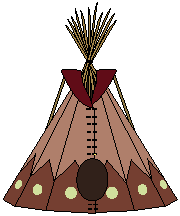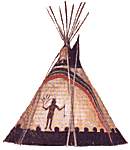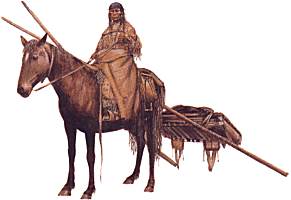FIRST NATIONS OF THE PLAINS
THE TIPI

The tipi was a very good shelter for the Plains First Nations.
It was easy to set up and take down.
It was warm in winter, cool in summer and waterproof.
SETTING UP THE TIPI
The women set up the tipi in less than an hour.
- Three or four long poles (made from pine trees) formed the basic frame.
- Once these poles were set firmly in the ground, the
other poles were placed against the frame in the form of a circle.
- The poles leaned together at the top and were fastened with
narrow strips of hides to form a cone shape.
- The poles were covered with bison hides and an opening (smoke hole) was left at the top.
- Two longer poles were attached to the smoke-flaps at the top of the tipi.
- The flaps were like a chimney which could be opened to allow the smoke to escape.
The flaps could be adjusted during bad weather (rain or snow).
- In hot weather the covering was rolled up from the bottom so that air could circulate.
- Wooden pegs were pounded into the ground around the bottom of the tipi covering.
- The opening (door) always faced east and the tipi was tilted towards the east.
A flap covered the opening.
- Depending on the size, it took 8 to 20 hides sewn together with sinew to make the tipi cover.
photo of tipi
at Royal Sask Museum
smoke-flaps

INSIDE THE TIPI
- The average tipi was five metres (sixteen feet) in diameter (width).
- There was enough sleeping room for five to seven people.
- A firepit inside was for cooking and for heat.
- The tipi was lined with bear, bison or deer skin in the winter.
- There was very little furniture inside.
- Beds made from bison skins were placed against
the outside walls.
- Backrests made of willows tied together with cords made it
more comfortable for people to sit.
- Fur-lined skins covered the floor.
- Food, clothing, tools and other belongings were kept in
parfleches
(pouches made of buffalo hide) and
leather bags . Food was also stored in
birchbark containers .
- Items and bags were hung from the poles or set against the walls inside the tipi.
THE OUTSIDE OF THE TIPI
Snow was piled along the outside of the tipi in the winter.
Rocks were also placed around the outside to stop the wind
from blowing the tipi over.
The outside was sometimes decorated with paintings of animals,
stars and other objects which had a special meaning to the owner.

MOVING
The women could take down a tipi in minutes.
The ends of two of the long poles were tied to a horse.
The other ends dragged on the ground, forming an A-shaped frame
called a travois.
The hides, and other family belongings were placed on the travois.

OTHER SHELTERS
The Wood Cree lived in tipis of caribou or moose hides.
In northern Saskatchewan where there were plenty of trees, log cabin shelters were
sometimes built for the winter.

| index |
introduction |
words |
beliefs |
food |
clothing |
tipi |
bison |
| decoration |
family & daily life |
tools |
transportation |
links |

** information for teachers **
credits for graphics and information
J.Giannetta, June 2002
(updated July 2011)
Web Pages for Students





